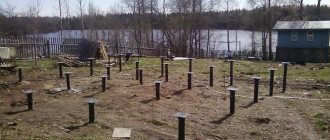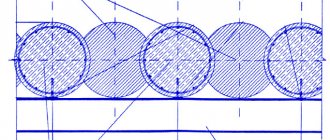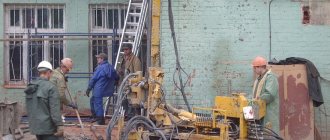The north and northeast of Russia contain 60% of the soil that is in a state of permafrost.
Therefore, building foundations on permafrost soil is a serious problem.
The construction of buildings on these types of soils requires a long preliminary stage before laying the foundation.
Which provides for in-depth engineering geocryological study.
Permafrost soils: characteristics, properties
Permafrost is considered to be those soils that have been in a frozen state for 3 or more years, they have an unstable structure, and upon thawing they undergo significant subsidence as a result of disturbances in the natural structural state.
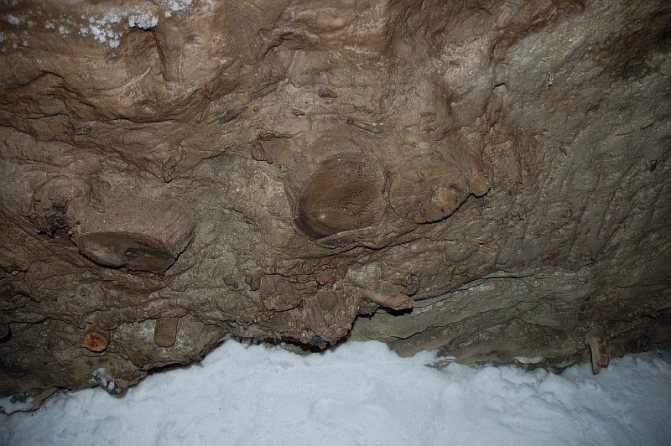
Section of permafrost soil
The permafrost layer is divided into two parts vertically:
The active layer is the surface layer of frozen soil that undergoes partial thawing during the summer season and freezes again with the onset of winter. Intensive processes of thawing and freezing of the soil cause heaving, which negatively affects the stability and strength of buildings built on this soil foundation.
The thickness of the active layer depends on the climate of the area and the geological composition of the underlying soil; it can range from 0.3 to 4.0 meters, while moving southward, the thickness of the active layer increases significantly. The surface layer reaches its greatest thickness in soils composed of sand and fragmented rocks that have open pores.
There are two types of active soils:
- Merging - in winter cold conditions, the soil of the active layer freezes to its entire thickness and freezes with the permafrost of the base on which it rests.
- Non-merging soils - between the active soil layer and the permafrost continental layer, there is a non-freezing bridge.
Permafrost - this soil layer is usually divided into two types:
- Continuous frozen layer - consists of a continuous homogeneous layer of frozen soil.
- The thickness is layered - represented by layers of frozen soils, ice inclusions or layers that are washed away by subsurface waters.
Permafrost can be composed of soils of any type, among which the main groups of soils are most widely represented. The smallest percentage of frozen soils consists of rocks.
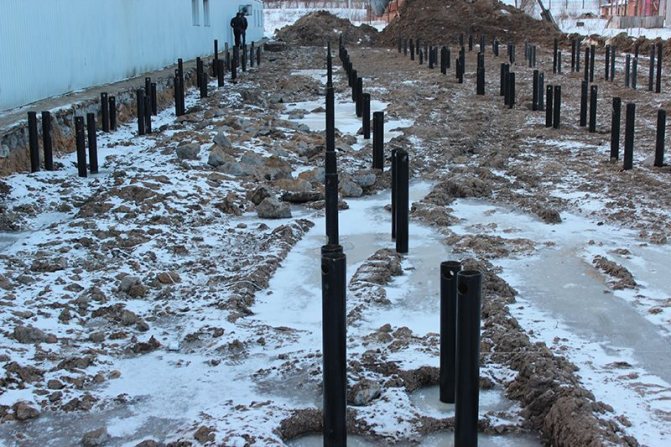
Hard frozen soil
Based on their condition, permafrost soils are usually divided into the following types:
- Hard frozen - this type is represented by frozen sand, which in a frozen state acquires all the properties and characteristics of rocky soil.
- Plastically frozen - consist of clayey rocks, which, as a result of deep freezing, contain frozen water, and can compress when exposed to certain loads.
- Granular frozen soils - this group consists of sandy and gravel soils, which, even in a frozen state, are not frozen and are in a fairly loose state.
Technological stages
The immersion of piles into the hard frozen mass is planned to perform the following operations:
- exploration of the territory followed by analysis of geological features;
- determination of the optimal technology and diameter of screw piles, taking into account research results and expected load;
- earthworks - defrosting (thawing) and/or drilling in accordance with the chosen method;
- the installation of shock-absorbing pads is realized by alternately filling each well with several layers of coarse sand and fine crushed stone with careful compaction using a special device or pipes of a smaller diameter;
- installation of metal poles using one of the available methods.
Filling the space around the protruding parts of the screw posts is usually carried out using concrete, cement-sand or cement-clay mortar. Sometimes hard continental strata are used: rocks, crushed stone, coarse sand, etc.
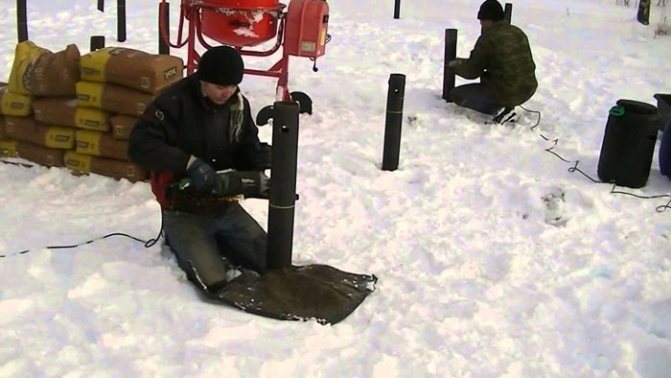
Features of foundations on permafrost
Foundations on permafrost soils require a special approach; special technology is used for their construction. Already at the time of designing a support foundation in permafrost conditions, a number of aspects should be taken into account:
- Development of measures to reduce possible deformations of the building.
- Careful calculation of foundation depth.
- Selecting the type of foundation based on local conditions.
- A technology for constructing building supports, developed for the construction of building foundations in permafrost (the method of immersing supports).
Building a house in any conditions is a responsible process that requires careful compliance with building codes and regulations; the work technology should be carried out with special care. In permafrost conditions, the construction of buildings should be approached even more responsibly, choosing a suitable foundation to support the building.
What does preliminary research include?

Taking soil for analysis
- information about the geological conditions of a specific building site (nature of occurrence, temperature, amount of thawing of the layer and its freezing, climate features in the region, etc.);
- materials on the study of soils, structural features, physical characteristics in a thawed and frozen state;
- information about future changes in conditions at the construction site (temperature conditions at the site, etc.);
- information for taking into account environmental protection measures in the project.
After completing the survey, the house is designed and the foundation is calculated.
At this stage, there are two options for using such soils as a base:
- preserve perpetually frozen soil in its natural state;
- design a house in such a way that its foundation will be in a thawed state.
The first option is the most popular and less expensive. However, the choice can only be made taking into account technical and economic calculations and efficiency.
Pile foundations

Compared to other types of foundations, a foundation on permafrost (pile) has significant advantages:
- The need to develop natural soil in a pit is eliminated, which is quite difficult to do due to the natural conditions of the area.
- Pile foundations in permafrost can be erected in any weather conditions, at any time of the year.
- The technology for constructing pile foundations (immersion method) is simple and accessible.
- Pile foundations in permafrost conditions are usually buried to great depths, so the danger of uneven settlement of the building and overturning of structures is eliminated.
It is necessary to carry out careful calculations of the depth of pile supports, taking into account the entire complex of operating factors according to geological and hydrogeological indicators, including the depth of seasonal freezing and thawing of the soil.
Particular attention should be paid to frost heaving of soils, which occurs in silty and clayey soils. Heaving of frozen soil is fraught with uneven settlement during seasonal thawing of the upper layers of frozen rock.
Pile supports, to a greater extent than other types of foundations, are able to resist the forces of frost heaving. The construction of foundations from piles for buildings in permafrost conditions, observing the necessary technology, guarantees the building stability, strength and durability.
In this article, we will consider in detail the technology for constructing pile foundations in permafrost areas.
Depth of groundwater and its significance
When laying the foundation of a future building, the depth of groundwater is of great importance: the higher it is, the higher the humidity will be and, accordingly, the lower the bearing capacity of the soil. In practice, this leads to the fact that during the construction of the foundation, as it approaches the water level, it will be regularly flooded by it.
It is strictly prohibited to pour the foundation without first pumping out the water and installing waterproofing. It is especially important to know about the level of groundwater when building on frozen soils. Firstly, such construction requires a large grounding depth, which, if the water level is high, can provoke flooding.
Secondly, the close location of water causes gradual thawing of frozen soil, which will inevitably lead to deformation of the structure. Therefore, it is very important before starting construction work to carry out the necessary studies of the area for the presence of groundwater.
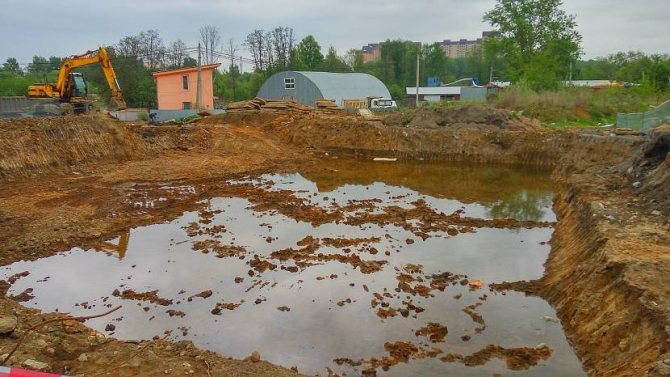
Groundwater on frozen soils appears during thawing Source static.imfast.com
Bored piles
Frame of an augered pile
The technology for constructing foundations from augered piles has been developed specifically for areas with permafrost soils.
The method of immersing supports includes performing basic technological operations:
- Immersion of square piles into a pre-prepared well that is larger in size than the support being immersed.
- Filling the gap between the pile support and the walls of the well with concrete mortar.
Pile supports, taking the load from the weight of the building and other influences, redistribute it to the lower layers of the soil, as well as to the side surfaces compressed by the soil.
The industry produces rectangular metal drilling supports. At the bottom of the barrel there is a widening with a fixed supporting element and stiffening ribs. A special cylindrical insert is installed between the pile body and the tip, which determines the load-bearing capacity of the entire supporting structure.
It is allowed to use square piles and shell piles for constructing the foundation base. To increase the strength of the last supports, it is necessary to concrete the internal cavity after completion of installation work.
The dimensions of pile supports are taken according to design calculations. To ensure increased strength, composite supports can be used, provided they are necessarily supported on a solid base.
We recommend watching a video describing the process of installing supports in frozen soils.
Dive Features
In areas with an average annual temperature range at a depth of 5–10 m below –1.5 0C, when constructing foundations in frozen soils, the technology of freezing support pillars with the structure of hard frozen strata is most often used. Screw supports are immersed in two methods: into pre-constructed wells, or into pre-thawed rock.
Drilling
Installation involves marking the territory and drilling using special equipment or a special installation. The equipment is located on a slag or crushed stone base with the possibility of prompt displacement to prevent the sliding of layers during excavation work. After the well is constructed, it is filled with solution in the volume necessary to fill the voids. At the next stage, the stand is lowered and the casing is then pulled out.
Thawing
Most often, defrosting is carried out using steam needles, the lower part of which is perforated. A hot medium supplied under a pressure of 0.6±0.2 MPa from the tip of the instrument liquefies the frozen rock to a fluid consistency, into which the needle gradually sinks.
The speed of installation depends on the structure of the site, the diameter of the required cavity and the required depth. With a small amount of ice, the process takes up to 3 hours, and with a large level of moisture saturation - up to 8 hours. The needle is lowered in such a way as to ensure a liquefied zone that is 2–3 times larger than the cross-section of the support.
After lowering the stand into the thawed liquid, natural freezing of the pipe surface with the permafrost occurs. As a result, the screw support quickly acquires the calculated load-bearing capacity parameters.
Garden and flower beds on frozen soils
When arranging a garden and flower beds on a personal plot, you should understand that not all crops are able to withstand harsh winters. Therefore, it is better to opt for frost-resistant plant varieties. In addition, it will be useful to find out what exactly takes root and grows well in a given area.

Not all plants can take root on frozen soil Source rasekhoon.net
Well or borehole on frozen ground
You can solve the issue of water supply on the site by digging your own well or borehole. However, doing this on frozen soil will be much more difficult than on normal soil.
To go deeper into the soil, especially if there are several meters to groundwater, you will need a special tool (a jackhammer), which can greatly facilitate the process.
You will also need to take care of measures against frost heaving, which can break the rings of the internal waterproofing of the well. To do this, it is recommended to use rings with special locks that prevent them from moving, or special brackets.
You also need to think about ways to externally insulate the structure.

